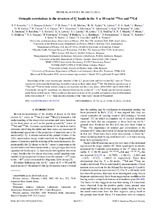| dc.contributor.author | Bvumbi, S.P. | |
| dc.contributor.author | Sharpey-Schafer, J.F. | |
| dc.contributor.author | Jones, P.M. | |
| dc.contributor.author | Mullins, S.M. | |
| dc.date.accessioned | 2018-02-27T12:12:38Z | |
| dc.date.available | 2018-02-27T12:12:38Z | |
| dc.date.issued | 2013 | |
| dc.identifier.citation | Bvumbi, S.P. et al. (2013). Octupole correlations in the structure of O2 bands in the N=88 nuclei150Sm Gd. Physical Review C, 87: 044333 | en_US |
| dc.identifier.issn | 0556-2813 | |
| dc.identifier.uri | http://dx.doi.org/10.1103/PhysRevC.87.044333 | |
| dc.identifier.uri | http://hdl.handle.net/10566/3538 | |
| dc.description.abstract | Knowledge of the exact microscopic structure of the 01
+ ground state and first excited 02
+ state in 150Sm is
required to understand the branching of double β decay to these states from 150Nd. The detailed spectroscopy of
150Sm and 152Gd has been studied using (α,xn) reactions and the γ -ray arrays AFRODITE and JUROGAM II.
Consistently strong E1 transitions are observed between the excited Kπ = 02
+ bands and the lowest negative
parity bands in both nuclei. These results are discussed in terms of the possible permanent octupole deformation
in the first excited Kπ = 02
+ band and also in terms of the “tidal wave” model of Frauendorf. | en_US |
| dc.language.iso | en | en_US |
| dc.publisher | American Physical Society | en_US |
| dc.rights | Physical Review C allows for the publisher's version to be uploaded to the authors' institutional repository. | |
| dc.subject | Octupole | en_US |
| dc.subject | Microscopic structure | en_US |
| dc.subject | Permanent octupole deformation | en_US |
| dc.title | Octupole correlations in the structure of O2 bands in the N=88 nuclei150Sm Gd | en_US |
| dc.type | Article | en_US |
| dc.privacy.showsubmitter | FALSE | |
| dc.status.ispeerreviewed | TRUE | |
| dc.description.accreditation | Web of Science | |

